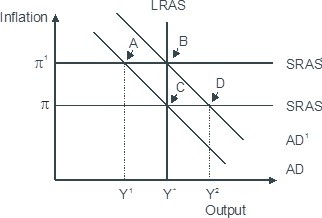For most students, the earnings they give up to attend college are
a. a minor cost when compared to the costs of tuition, room and board, and the like.
b. the single largest cost of their education.
c. about equal to the costs of room and board at college.
d. not considered true costs by an economist.
b
You might also like to view...
Based on the figure below. Starting from long-run equilibrium at point C, a tax cut that increases aggregate demand from AD to AD1 will lead to a short-run equilibrium at point ________ and eventually to a long-run equilibrium at point ________, if left to self-correcting tendencies. 
A. D; C B. B; C C. B; A D. D; B
If interest rates and output rises, then
a. government spending may have fallen. b. the money supply may have risen. c. taxes may have risen. d. expectations may have risen. e. none of the above.
The supply of loanable funds reflects the willingness of
a. businesses to borrow loanable funds for new capital at various interest rates b. consumers to spend loanable funds for items, such as new cars, at various interest rates c. savers to provide loanable funds to the loanable funds market at various interest rates d. firms to provide the funds, which is why production occurs in the first place e. people to invest in business enterprise, if the price is right (meaning if the interest rate is right)
In the absence of environmental protection laws, firms pollute because:
A. business owners do not believe that pollution is a problem. B. controlling emissions costs money, thereby reducing profits. C. business owners follow different norms than do environmentalists. D. the cost pollution imposes on society is small relative to the cost of reducing pollution.